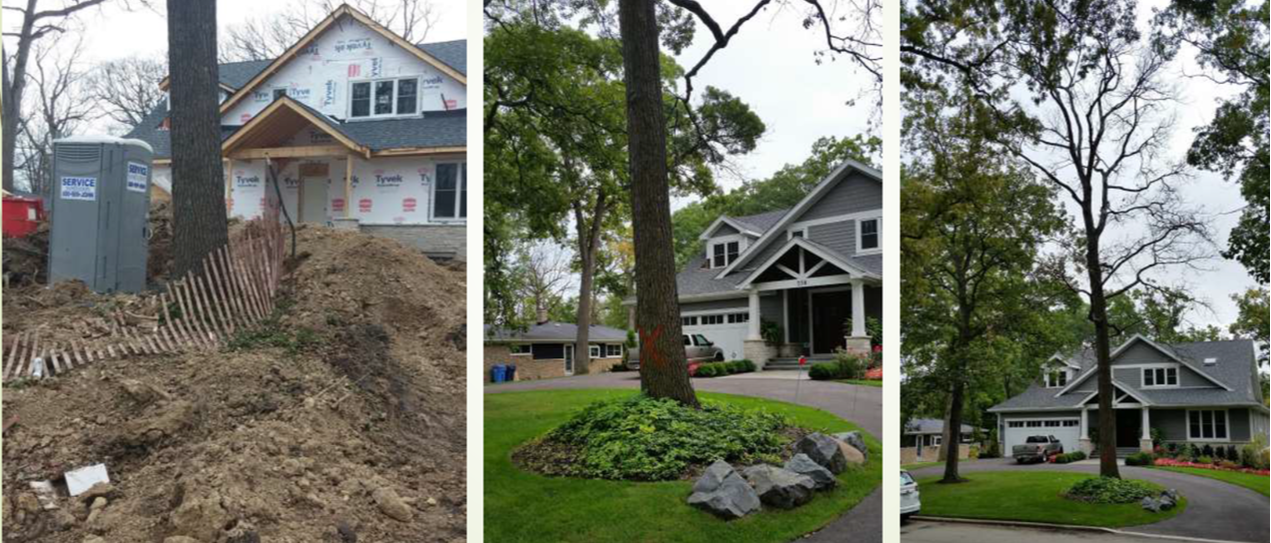Project PersonnelLUFA Personnel: Kaitlyn Pike (project lead; former LUFA student), Jess Vogt
Collaborators: Dr. Keith O'Herrin (former Highland Park City Forester, currently with extension in Union County, North Carolina) Project Description |
Tree preservation in urban areas is critical to the continued provision of the benefits of urban trees to residents. Especially in residential areas - which, together with vacant lands, account for as much as 75% of total urban tree canopy cover in cities - the preservation of trees during development and redevelopment is necessary to managing stormwater runoff, air quality, temperatures amidst the urban heat island, not to mention preserving aesthetic and human health and wellbeing benefits.
In Highland Park, Illinois, LUFA has been working with collaborator Dr. Keith O'Herrin to investigate the outcomes of the municipality's tree preservation ordinance, which mandates certain tree preservation practices during construction (e.g., tree preservation fencing around a critical root zone) and mandates permitting for removal of trees larger than 8" in diameter. Former LUFA student Kaitlyn Pike (now a PhD student at the University of British Columbia) examined the efficacy of the Highland Park tree preservation ordinance in her master's thesis, observing a preservation rate of 75% and no measurable correlation between tree mortality or condition and proximity to newly installed foundations (Pike, O'Herrin, Klimas, & Vogt 2021).
A follow-up study to Kaitlyn's master's thesis research surveyed Highland Park builders and homeowners about construction practices and preferences for trees. The home builders' survey results were then compared to a prior iteration of the same survey conducted in a rural location. Results of that research, from the abstract of O'Herrin, Hauer, Pike, & Vogt (2022): "Overall, there were more similarities than differences between the two groups though some of those differences are very important. Urban builders and rural builders scored a very similar average of correct responses on questions testing their knowledge: 63% and 65%, respectively. The major difference between urban and rural appears to be in activities as dictated by ordinance. Urban builders were more likely to consult tree preservation experts and use tree fence to create tree protection zones. The successful tree preservation outcomes in the urban community are likely a direct result of ordinance requirements and enforcement by the City Forester, not builders’ knowledge or their conscious decisions."
In Highland Park, Illinois, LUFA has been working with collaborator Dr. Keith O'Herrin to investigate the outcomes of the municipality's tree preservation ordinance, which mandates certain tree preservation practices during construction (e.g., tree preservation fencing around a critical root zone) and mandates permitting for removal of trees larger than 8" in diameter. Former LUFA student Kaitlyn Pike (now a PhD student at the University of British Columbia) examined the efficacy of the Highland Park tree preservation ordinance in her master's thesis, observing a preservation rate of 75% and no measurable correlation between tree mortality or condition and proximity to newly installed foundations (Pike, O'Herrin, Klimas, & Vogt 2021).
A follow-up study to Kaitlyn's master's thesis research surveyed Highland Park builders and homeowners about construction practices and preferences for trees. The home builders' survey results were then compared to a prior iteration of the same survey conducted in a rural location. Results of that research, from the abstract of O'Herrin, Hauer, Pike, & Vogt (2022): "Overall, there were more similarities than differences between the two groups though some of those differences are very important. Urban builders and rural builders scored a very similar average of correct responses on questions testing their knowledge: 63% and 65%, respectively. The major difference between urban and rural appears to be in activities as dictated by ordinance. Urban builders were more likely to consult tree preservation experts and use tree fence to create tree protection zones. The successful tree preservation outcomes in the urban community are likely a direct result of ordinance requirements and enforcement by the City Forester, not builders’ knowledge or their conscious decisions."
Publications
Titles link to full-text when available.
O’Herrin K, Hauer R, Pike K, Vogt J (2022) Homebuilder activities and knowledge of tree preservation during construction: Comparison of practitioners in rural and urban locations. Sustainability 14(5), 2753. https://doi.org/10.3390/su14052753
Pike K, O’Herrin K, Klimas C, Vogt J (2021) Tree preservation during construction: An evaluation of a comprehensive municipal tree ordinance. Urban Forestry & Urban Greening, 57: 126914. https://doi.org/10.1016/j.ufug.2020.126914
Presentations & Posters
O’Herrin K, Pike K (2021) Long-term Effectiveness of a Strict Tree Preservation Ordinance. Arbor Day Foundation Partners in Community Forestry Conference. Louisville, KY. November 17-18, 2021. [Link to video of presentation.]
Pike K, O'Herrin K, Vogt J (2020) Tree preservation during construction: Long-term evaluation of a progressive municipal tree ordinance. International Society of Arboriculture 2020 Virtual Conference, December 7-11, 2020. [Virtual poster presentation.]
Data Collection Instruments
Funding & Support
Kaitlyn Pike's M.S. thesis research was supported by:
- Garden Club of America Zone IV Fellowship in Urban Forestry, 2018, $5,000
- Center for Tree Science Graduate Research Fellowship from the Morton Arboretum (2018-19: $9,379; 2019-2020: $14,919)
- DePaul University Department of Environmental Science and Studies provided support via paid undergraduate field assistants for summer 2019





